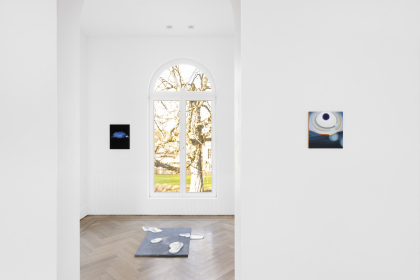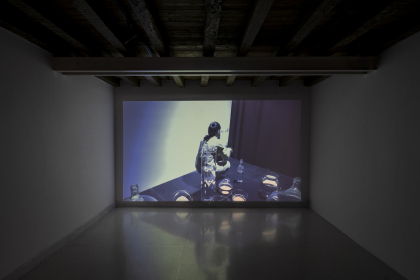
Are you coming or going ? An analog puppetry of light behavior
Isabel Fredeus’ solo exhibition 'Are you coming or going? An analog puppetry of light behavior' at Whitehouse Gallery is centered on a video installation under the title 'A Subjective Reality'.
In this video composed of four performances, the artist deploys conversations with different materials. Isabel Fredeus’ interactions with light and fluids lead to unforeseen events and transformations, highlighting the process and emphasizing its importance throughout the work. In the video the artist orchestrates a fragile balance between her Subjectivity and Reality by the means of arranging objects in space and letting them interact.
Sculptures, drawings and photographs are displayed as remnants of past processes. They are testimony of collaborations between the artist and the plasticity of the materials she uses, such as glass, plaster, iron.
In 'Acid Trip', Fredeus proposes the observation of shells immersed in acidic water and destined to dissolve over the course of hours, days, weeks. Accelerating the course of the dissolution, the fragility of the external envelope reveals the complexity of its internal structure and hints at the impermanence of the living. Here the drawing is made by itself once the artist has activated the installation by plunging the shells one by one in the vases. The lines of the shells are drawn increasingly clear until they disappear.
The notion of drawing is central in this series of performances. "The thinker is very much like a drawer who would like to reproduce all the relations of things between each other" writes Wittgenstein. Things are indeed brought together by the artist to be arranged and live drawn as if in a constant game. Fredeus’ performances unwind the thread of permanent transformation.
Projected on multiple screens, the video recording of 'Set the course' and 'Are you coming or going?' shows the artist in the process of arranging objects and manipulating different materials and fluids. These living paintings gradually emancipate themselves and solidify for a moment to create stable images.
'Pair Production' is the last performance in 'Subjective Reality'. It shows Isabel Fredeus placing a set of mirrors, one by one, at the bottom of a basin. The mirrors cast light on a screen where the water's surface is projected. The title of the performance refers to the idea of a single object composed of two similar parts. These two parts are, the real constituted of physical objects, assembled and arranged by the artist in a certain order and the shimmering projection of another reality, poetic, fluid and impermanent.
December 2022: Conversation between Isabel Fredeus and Alizée Gazeau
Alizée Gazeau: I would like to start our conversation with the video 'A Subjective Reality'. You are showing a 45-minute video made in 2021 on the occasion of 'Are you coming or going ? An analog puppetry of light behavior'. This archive of performances unfolds the processes of the elaboration of your works.
Isabel Fredeus: I liked the title because it's actually an English saying. 'Are you coming or going?' means that you are traveling through.
AG: The video is screened in the exhibition space while you also exhibit pieces extracted from the video, from the ongoing process shown in the video.
Speaking of the process, my question links with permanent movement. The video is independent from the pieces exhibited in the show. It illustrates a permanent flow of things evolving by themselves. You interact with them and you create something that changes, perturbs or helps things to evolve. This interaction leads to the idea of transformation in an act of cooperation.
IF: Yes, definitively. This is also a question of the material I use. I thought about this idea of perpetual movement. When you look at a table, it seems to be a very still and vast object, but all the atoms are in constant movement, they are vibrating at high frequencies. Matter is in a constant flow and movement and I was always interested in the possibilities of making it visible. Matter then becomes less plastic. With this performance, I show how light has an effect on the movements between 2D and 3D. I really loved to discover some characteristics about materials. In the glass works, lights movements make qualities visible and the reflected image was a totally different reality from the object itself. In the performance I could really search for the qualities of different objects by sending light through them. This simple movement helps me give another information, drawing imprints.
AG: In the performances you are questioning the materiality of water, light, objects. During this process, you emphasize on the questioning itself rather than the answers. To me this seems to be a testimony to our time, to our relationship to creation. It is also a matter of trust: working with a material and letting it act and behave independently, is a matter of trust.
IF: Yes, it is also nice to transfer the responsibility to the material to see the process as a cooperation. Working with this material is about flexibility toward process. I give them a way of astonishing me or I let them be what they are and accept it. I never know in advance what will happen, and when I overcontrol the process I realize I mostly don't like the work.
AG: It can lead us to think about the question of aesthetics. What would you say about the notion of beauty? You are taking care of the process, cooperating with the materials, sharing the responsibility and afterwards you have your own subjectivity, your own perception of beauty.
IF: I have to make choices.
AG: What would you do ? How to react to the final shapes of objects ?
IF: Things work when they aren't problematic anymore. I can mentally let them go. When a piece is not good enough, I am mostly overthinking it. We slightly direct the process but there is this delicate balance, this game between letting things happen and maintaining certain rules in the studio. These rules are important not to be overwhelmed by numerous options. When I work with glass for instance, I would keep the material as natural as possible.
AG: The definition of a relationship is to let the other act while keeping your own vision. 'Pair Production' illustrates it perfectly. The notion of transparency. This flat surface of water is reflecting on a live screen. You arrange mirrors in the water one by one. You are very present in the video, all your body being involved, carrying the mirrors, walking in the water.
IF: This is an imagery through reflections. In this performance I create an image through this material. I am even more interested in how it is created and built up.
AG: When you put the mirrors under the water, you create a vibration. This is central in the performance and links together transparency and process.
IF: I also like the simplicity of it. It is not as if it were a scientific demonstration.
AG: This is not a scientific but a poetic elaboration. In your book edited in collaboration with Ines Cox, for 'Pair Production', you printed blocks with glossy surfaces: the mirrors on the floor. They form an architectural whole. It reminds me of the construction of verses in poetry. They are assembled in a certain way in order to tend towards an idea of harmony. They are forming blocks of words, thoughts, images, from which emerges a vibration. The physical vibrations of the water create ideas and images.
IF: Water is a vector of ideas and potentialities. Speaking of which, it was a conversation about water that led us to collaborate with the two group exhibitions 'Off Water' you curated in Berlin at Gr_und in November 2021 and in Paris at Sainte Anne Gallery in May-June 2022.
AG: In the two performances, 'To set the course' and 'Are you coming or going? An analogue puppetry of light behavior', you are making drawings. What would you say about the place of drawing in your work?
IF: In general I like working within a frame, inside this imaginary window. The difference between creating 2D imagery or 3D sculpture is interesting. When I work on a sculpture it directly relates to my environment. The drawings diverge from the typical window: a mental space to imagine another reality. In 'To set the course' there are these liquids that are moving and waiting for each other.
AG: Would you say that you are 'the pilot' ? I am referring to the sentence you wrote to illustrate the performance in your book: 'Before I thought that it was rather the wind, then the pilot set the course.'
IF: This was my first attempt at poetry. Yes, I would consider myself indeed as a pilot.
AG: There is this sentence from Virginia Woolf in The Waves: 'Let us again pretend that life is a solid substance, shaped like a globe, which we turn about in our fingers. Let us pretend that we can make out a plain and logical story, so that when one matter is despatched - love for instance - we go on, in an orderly manner, to the next.'
During the performances, you fully occupy the room. You are putting in order a multitude of potentialities. In the performance 'Acid Trip' for instance, the shells are progressively discovering their inner complexities by uncovering their external surfaces. You set off this disturbance and then move on to the next performance.
IF: Yes, the evolution of things, the process emancipates itself and that is part of my relationship to creation. The subjects that interest are always turned towards the natural processes. I cooperate, produce and create imagery with them. In the video the camera is following my movements, it is not a still image, you experience the flow of the performances.
December 2022
Alizée Gazeau









